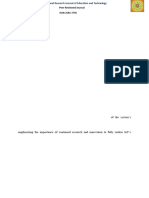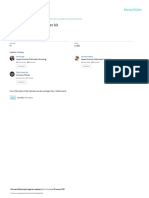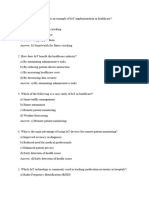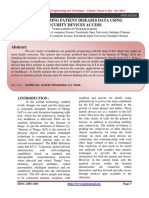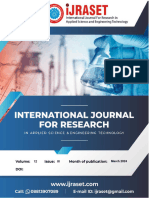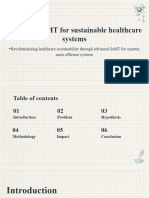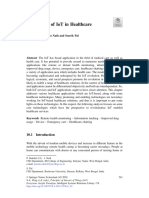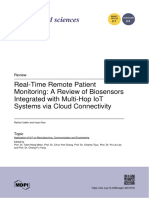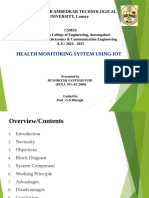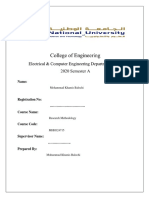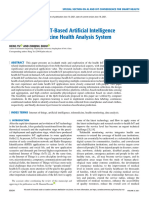0 ratings0% found this document useful (0 votes)
2 views19DCS148
19DCS148
Uploaded by
waxape9612Copyright:
© All Rights Reserved
Available Formats
Download as PDF, TXT or read online from Scribd
19DCS148
19DCS148
Uploaded by
waxape96120 ratings0% found this document useful (0 votes)
2 views5 pagesCopyright
© © All Rights Reserved
Available Formats
PDF, TXT or read online from Scribd
Share this document
Did you find this document useful?
Is this content inappropriate?
Copyright:
© All Rights Reserved
Available Formats
Download as PDF, TXT or read online from Scribd
Download as pdf or txt
0 ratings0% found this document useful (0 votes)
2 views5 pages19DCS148
19DCS148
Uploaded by
waxape9612Copyright:
© All Rights Reserved
Available Formats
Download as PDF, TXT or read online from Scribd
Download as pdf or txt
You are on page 1of 5
CS449-Internet of Things
Float Date: 03/10/2023 Submission Date: 12/10/2023
Note: Plagiarism should not be more than 10%.
Case Study Assignment
Case Study 1: A state of the art usage of IoT in Healthcare.
Case Study 2: IoT is a very useful now days for automation in
Manufacturing Industries.
Case Study Submission Template
Student Name Pinak Thakar
Roll No. 19DCS148
CASE STUDY TITLE A state of the art usage of IoT in Healthcare.
Summary In the contemporary healthcare landscape, the integration of the
Internet of Things (IoT) has brought about a revolutionary change in
patient care and management. This case study delves into an
innovative implementation of IoT in a state-of-the-art healthcare
facility. By harnessing IoT devices for real-time monitoring and data
analytics, the facility has achieved remarkable outcomes. Patients
now experience the benefits of continuous remote monitoring, which
allows for the early detection of health issues, ultimately leading to
improved treatment results. Healthcare professionals gain access to
a wealth of real-time patient data, enabling them to make quicker and
more informed decisions. Additionally, operational efficiencies have
led to significant cost reductions, all the while maintaining robust
data security and compliance with healthcare data privacy
regulations. This case study highlights the transformative potential of
IoT in healthcare and serves as a guiding light for the industry's future
prospects.
Issue to be resolved 1. Data Security and Privacy: Safeguarding patient data from
(At least five Sentence) unauthorized access and breaches is a top priority due to the
sensitive nature of healthcare information. Compliance with data
privacy regulations like HIPAA is a must.
2. Interoperability: Ensuring seamless communication and data
sharing among diverse IoT devices and systems poses a significant
challenge. Standardization and compatibility are crucial.
3. Scalability: Healthcare organizations must plan for scalability as
they expand their IoT deployments to accommodate a growing
number of devices and increased data volume.
4. Reliability and Uptime: Maintaining high levels of reliability
and uptime for IoT devices is critical for patient safety and care in
healthcare systems.
5. Cost Management: Managing the substantial initial costs of IoT
implementation and ongoing maintenance while ensuring quality
of care is a key concern for healthcare organizations.
6. Training and Adoption: Healthcare professionals may require
training to effectively use IoT devices. Ensuring staff are
comfortable with the technology and can maximize its benefits is
essential.
7. Ethical and Legal Challenges: Beyond data privacy, ethical
considerations like informed consent and responsible use of IoT
data are important. Healthcare organizations must navigate these
issues while adhering to evolving legal requirements.
1. Patients: Patients benefit from improved care through
Beneficiaries continuous monitoring, timely intervention, and the ability to
manage chronic conditions more effectively from the comfort of
their homes. IoT enables a higher quality of life for patients by
offering personalized healthcare.
2. Healthcare Providers: Physicians, nurses, and other healthcare
professionals gain access to real-time patient data, enabling quicker
and more informed decision-making. This can lead to more
accurate diagnoses, better treatment plans, and improved patient
outcomes.
3. Healthcare Facilities: Hospitals and clinics benefit from
increased operational efficiency, reduced costs, and enhanced
resource utilization. IoT can streamline workflows, minimize
errors, and optimize the allocation of resources.
4. Government and Regulators: Governments and healthcare
regulators can use IoT data to monitor and improve public health
outcomes. It can also aid in the development of health policies and
regulations.
Impact over 1. Patients experience improved health outcomes with remote
Beneficiaries monitoring and early intervention, enhancing their overall quality
(At least five Sentence) of life.
2. Healthcare providers benefit from real-time data access,
enabling more accurate diagnoses and treatment plans, ultimately
leading to better patient care.
3. Healthcare facilities see enhanced operational efficiency, cost
savings, and optimized resource allocation, resulting in improved
services.
4. Researchers gain access to a wealth of data for medical research,
potentially leading to breakthroughs in disease understanding and
treatment.
5. Insurance companies utilize IoT data for better risk assessment
and the customization of health plans, benefitting policyholders.
6. Caregivers and family members experience peace of mind
through remote health monitoring, enabling them to provide more
personalized care and support.
Technologies to build 1. Wireless Communication Protocols: Technologies such as Wi-Fi,
( Write specific Bluetooth, Zigbee, and cellular networks enable data transmission
detailing of between IoT devices and central systems.
technologies)
2. Sensors: A variety of sensors, including temperature sensors,
heart rate monitors, and blood pressure sensors, collect vital patient
data, playing a crucial role in real-time monitoring.
3. Cloud Computing: Cloud platforms like AWS, Azure, or Google
Cloud are utilized to store and process the vast amounts of data
generated by IoT devices, making it accessible from anywhere.
4. Data Analytics: Big data analytics tools, machine learning
algorithms, and AI systems process and analyze the collected data
to extract meaningful insights for healthcare professionals.
5. Blockchain: Blockchain technology ensures the integrity and
privacy of patient data, providing secure and tamper-proof data
storage and sharing.
6. Mobile Applications: Tailored mobile applications for both
patients and healthcare providers facilitate easy access to real-time
data and support remote monitoring and communication.
7. Edge Computing: Edge devices or gateways locally process
data, reducing latency and ensuring that critical information
remains available even in cases of unreliable network connections.
9. Security Solutions: IoT security measures encompass
encryption, access controls, and regular security audits to safeguard
patient data and ensure compliance with healthcare regulations.
Any other information In conclusion, the implementation of IoT technologies in
(Any Relevant thing healthcare has ushered in a new era of patient-centric care and
which you want to add) operational efficiency. These technologies have positively
impacted patients, healthcare providers, facilities, and various
stakeholders by enabling real-time monitoring, data-driven
decision-making, and enhanced healthcare services. As technology
evolves and more healthcare organizations embrace IoT, the future
promises even more advanced solutions that will further transform
the healthcare industry for the better.
Devang Patel Institute of Advance Technology and Research (DEPSTAR)
Department of Computer Science & Engineering
You might also like
- Sample Templeate - Case Study ReportDocument6 pagesSample Templeate - Case Study Reportmanishkadem99No ratings yet
- Introduction To IoT in HealthcareDocument8 pagesIntroduction To IoT in Healthcarefancricketer970No ratings yet
- IoT Application in HealthcareDocument9 pagesIoT Application in HealthcareDimas AtmojoNo ratings yet
- Revolutionizing Healthcare Management Integrating IoT and Digital Frameworks For Enhanced Medical Information SystemsDocument11 pagesRevolutionizing Healthcare Management Integrating IoT and Digital Frameworks For Enhanced Medical Information SystemsWeb ResearchNo ratings yet
- Author'S Copy Author'S CopyDocument5 pagesAuthor'S Copy Author'S Copyziafat shehzadNo ratings yet
- Iot Based Smart Healthcare Kit: March 2016Document7 pagesIot Based Smart Healthcare Kit: March 2016Gajalakshmi AshokNo ratings yet
- Q.B Session 30Document11 pagesQ.B Session 30Shabbir AliNo ratings yet
- Introduction To IoT in HospitalsDocument9 pagesIntroduction To IoT in Hospitalsmonikamirnaa485No ratings yet
- Proposed System Using Iot and Gis To Generate Electronic Medical RecordsDocument11 pagesProposed System Using Iot and Gis To Generate Electronic Medical Recordsindex PubNo ratings yet
- Ijet V3i6p2Document6 pagesIjet V3i6p2International Journal of Engineering and TechniquesNo ratings yet
- Eai Endorsed Transactions: Cloud Based Iot Smart Healthcare System For Remote Patient MonitoringDocument11 pagesEai Endorsed Transactions: Cloud Based Iot Smart Healthcare System For Remote Patient Monitoringpkibaki081No ratings yet
- Paper 4Document12 pagesPaper 4Samrat AshishNo ratings yet
- IoT Marketing For Primary CareDocument28 pagesIoT Marketing For Primary CareASGNo ratings yet
- Healthcare Technology Evolution and Adoption of Fog Computing in Healthcare: Review, Issue and ChallengesDocument10 pagesHealthcare Technology Evolution and Adoption of Fog Computing in Healthcare: Review, Issue and Challengespatil.maNo ratings yet
- A Secure Framework For Authentication and Encryption Using Improved ECC For IoT-Based Medical Sensor DataDocument10 pagesA Secure Framework For Authentication and Encryption Using Improved ECC For IoT-Based Medical Sensor DataMysha RahmanNo ratings yet
- Major Progect FinalDocument18 pagesMajor Progect Finalkottamidyabhoomika05No ratings yet
- Research Paper 1Document11 pagesResearch Paper 1Abhay GargNo ratings yet
- Biostatistics - Bachelor of Science in Public Health by SlidesgoDocument10 pagesBiostatistics - Bachelor of Science in Public Health by SlidesgogweqrgthytwertyNo ratings yet
- Digital Hospital and Patient Monitoring SystemDocument4 pagesDigital Hospital and Patient Monitoring SystemRahul SharmaNo ratings yet
- Blockchain-Based Secure Healthcare Application For Diabetic-Cardio Disease Prediction in Fog Computing PDFDocument15 pagesBlockchain-Based Secure Healthcare Application For Diabetic-Cardio Disease Prediction in Fog Computing PDFBhuvana SenthilkumarNo ratings yet
- Chapter 10Document15 pagesChapter 10Ivan SatriaNo ratings yet
- Iot For Health CareDocument6 pagesIot For Health CareRAJSHEKHAR PATILNo ratings yet
- Iot in Health CareDocument3 pagesIot in Health CareDAWIT FIKADUNo ratings yet
- Electronics 12 02050 v3Document19 pagesElectronics 12 02050 v3abhishekrameshkumar12No ratings yet
- Blockchain-IoT Healthcare Applications and Trends A ReviewDocument35 pagesBlockchain-IoT Healthcare Applications and Trends A ReviewAnil Kumar PawarNo ratings yet
- Applsci 14 01876 With CoverDocument37 pagesApplsci 14 01876 With Covercaroline lucasNo ratings yet
- E13d3a1e91b5f0fe PDFDocument12 pagesE13d3a1e91b5f0fe PDFSindhu VelayudhamNo ratings yet
- IoT Based E Health Monitoring and Room Environment Controlling Multi Function Smart Device With SmarDocument6 pagesIoT Based E Health Monitoring and Room Environment Controlling Multi Function Smart Device With SmarPraba Pushparaj PNo ratings yet
- Iotm 125Document7 pagesIotm 125vijaypurushoth70No ratings yet
- Real Time Remote Monitoring Via Horse Head Optimization Deep Learning NetworkDocument6 pagesReal Time Remote Monitoring Via Horse Head Optimization Deep Learning Networkeditor.ijdsaiNo ratings yet
- Research Paper IJRASETDocument11 pagesResearch Paper IJRASETadnanh.sepNo ratings yet
- Internet of Things in Healthcare: Architecture, Applications, Challenges, and SolutionsDocument12 pagesInternet of Things in Healthcare: Architecture, Applications, Challenges, and SolutionsVatsal Shah100% (1)
- A Topical Review On Enabling Technologies For InteDocument34 pagesA Topical Review On Enabling Technologies For Interianto panddhuNo ratings yet
- Seminar PPTrushiDocument14 pagesSeminar PPTrushiwshreyash272No ratings yet
- Ejemplo IEEDocument47 pagesEjemplo IEEFranko AlgarinNo ratings yet
- 1 s2.0 S0045790622002440 MainDocument18 pages1 s2.0 S0045790622002440 MainNeha NehaNo ratings yet
- Cloud Based Home Health Care Systems Using IoTDocument3 pagesCloud Based Home Health Care Systems Using IoTInternational Journal of Innovative Science and Research TechnologyNo ratings yet
- A Secure Data E-Governance For Healthcare ApplicatDocument17 pagesA Secure Data E-Governance For Healthcare ApplicatMuhammad TanveerNo ratings yet
- Healthcare Monitoring System For Remote AreasDocument7 pagesHealthcare Monitoring System For Remote AreasIJRASETPublicationsNo ratings yet
- Ria 37.02 22Document15 pagesRia 37.02 22rajivfr144No ratings yet
- Liu, 2022Document19 pagesLiu, 2022Rizky HanzNo ratings yet
- Software Engineering in HealthcareDocument5 pagesSoftware Engineering in HealthcareIJRASETPublicationsNo ratings yet
- Seminar PPT (1) TechnicalDocument23 pagesSeminar PPT (1) Technicalnejeavadhut4No ratings yet
- Name:: Mohammad Khamis BalochiDocument7 pagesName:: Mohammad Khamis BalochiNaveed Akhtar BalochNo ratings yet
- Optimization of IoT-Based Artificial Intelligence Assisted Telemedicine Health Analysis SystemDocument15 pagesOptimization of IoT-Based Artificial Intelligence Assisted Telemedicine Health Analysis Systemzainab.albyoodNo ratings yet
- Chapter 11Document26 pagesChapter 11Ivan SatriaNo ratings yet
- The Dynamic Role of Internet of Things (Iot) Based Applications in Healthcare Devices For Enhancing Efficacy of TreatmentDocument12 pagesThe Dynamic Role of Internet of Things (Iot) Based Applications in Healthcare Devices For Enhancing Efficacy of TreatmentNorchene Ben Dahmane MouelhiNo ratings yet
- Paper 2Document28 pagesPaper 2Samrat AshishNo ratings yet
- Design of Health Care Monitoring System Based On Internet of Thing (IOT)Document7 pagesDesign of Health Care Monitoring System Based On Internet of Thing (IOT)badhautiyaakash48No ratings yet
- The Study of Internet of Things (Iot) - BasedDocument5 pagesThe Study of Internet of Things (Iot) - BasedSuleeman CabdulaahiNo ratings yet
- Survey On Smart Healthcare: An Application of IotDocument4 pagesSurvey On Smart Healthcare: An Application of Iotpiyumi nisansalaNo ratings yet
- Security and Privacy in The Internet of Things Healthcare Systems - Toward A Robust Solution in Real-Life DeploymentDocument8 pagesSecurity and Privacy in The Internet of Things Healthcare Systems - Toward A Robust Solution in Real-Life DeploymentputmyNo ratings yet
- Summary of The Study: Iot Based Remote Patient Health Monitoring SystemDocument5 pagesSummary of The Study: Iot Based Remote Patient Health Monitoring System03052256790No ratings yet
- Chatterjee 2017Document5 pagesChatterjee 2017sofiane PicantoNo ratings yet
- CSEIT1831304Document4 pagesCSEIT1831304YogeshNo ratings yet
- IoT Medication Adherence PlatformDocument7 pagesIoT Medication Adherence PlatformMmanti UmohNo ratings yet
- The Digital Health Revolution: How Technology is Transforming Global Well-BeingFrom EverandThe Digital Health Revolution: How Technology is Transforming Global Well-BeingNo ratings yet
- Internet of Things (IoT): Introduction to IoT. Advancements and Communication Protocols. Part 1From EverandInternet of Things (IoT): Introduction to IoT. Advancements and Communication Protocols. Part 1No ratings yet
- Understanding IoT: Tips, Recommendations, and Strategies for SuccessFrom EverandUnderstanding IoT: Tips, Recommendations, and Strategies for SuccessNo ratings yet
- Internet of Things (IoT): Future of IoT. Ethics and Governance/ Part 3From EverandInternet of Things (IoT): Future of IoT. Ethics and Governance/ Part 3No ratings yet
- Tesis Macro TgaDocument115 pagesTesis Macro TgaCarlos Ubillas AlcaldeNo ratings yet
- Brief Contents 404Document39 pagesBrief Contents 404suriahannaNo ratings yet
- Moles 3Document4 pagesMoles 3Rafid Al NahiyanNo ratings yet
- Stress Analysis and Design Optimization of A Pressure Vessel Using Ansys PackageDocument12 pagesStress Analysis and Design Optimization of A Pressure Vessel Using Ansys Packageanthony zegarra ochoaNo ratings yet
- EthologyDocument7 pagesEthologyOnnNo ratings yet
- SDS NITOFLOR SL1000 IndiaDocument29 pagesSDS NITOFLOR SL1000 IndiaMaha MuflehNo ratings yet
- CLASS PROGRAM G11 LevelDocument5 pagesCLASS PROGRAM G11 LevelPetRe Biong PamaNo ratings yet
- Fadia Sherli Asyifa - 20210310068 - Ku 2Document1 pageFadia Sherli Asyifa - 20210310068 - Ku 2Lisa RLNo ratings yet
- Catalogo 2018 Artros PDFDocument38 pagesCatalogo 2018 Artros PDFBoris De La Cruz CalleNo ratings yet
- A Review On Role of Bio-Fertilizers in Fruit Crops: Plant ArchivesDocument5 pagesA Review On Role of Bio-Fertilizers in Fruit Crops: Plant ArchivesParth HatiskarNo ratings yet
- Pure Epoxy Fx-E400: Technical Data SheetDocument7 pagesPure Epoxy Fx-E400: Technical Data SheetRana Ahmad Aamir100% (1)
- Executive SummaryDocument14 pagesExecutive SummarySyed MubarakNo ratings yet
- Isbar WorksheetsDocument2 pagesIsbar Worksheetsapi-688564858No ratings yet
- SK Wallpaper Floral PVC Self Adhesive Waterproof Wallpaper Fabric Safety Home Decor Wall Covering For Living Room Bedroom Backgr PDFDocument1 pageSK Wallpaper Floral PVC Self Adhesive Waterproof Wallpaper Fabric Safety Home Decor Wall Covering For Living Room Bedroom Backgr PDFReighnn CarnacetoNo ratings yet
- Paleo Canteen Low Carb On A Budget PDFDocument37 pagesPaleo Canteen Low Carb On A Budget PDFHaroldo FalcãoNo ratings yet
- Navi Mumbai IDocument14 pagesNavi Mumbai IPrathmesh R MulukNo ratings yet
- Short Case II: Jufri Febrianto, MDDocument16 pagesShort Case II: Jufri Febrianto, MDsingle_ladyNo ratings yet
- Money MateDocument3 pagesMoney MateCrystal Dawn RobyNo ratings yet
- Axali, Damatebiti Tipobrivi Sagamocdo Testuri Sekitxvebi Medicinis Fakultetis Iii Kursis Studentebisatvis Mikrobiologia 2-SiDocument15 pagesAxali, Damatebiti Tipobrivi Sagamocdo Testuri Sekitxvebi Medicinis Fakultetis Iii Kursis Studentebisatvis Mikrobiologia 2-SiMKGUNo ratings yet
- Soil Report - ThankotDocument67 pagesSoil Report - ThankotSaumya ShresthaNo ratings yet
- Assignment 01: Shaikh Ayaz University ShikarpurDocument7 pagesAssignment 01: Shaikh Ayaz University ShikarpurAakib Arijit ShaikhNo ratings yet
- Lipofectamine 2000 Reag ProtocolDocument2 pagesLipofectamine 2000 Reag ProtocolBrian GoodwinNo ratings yet
- ZECCHI 05. All About Mothers. Pronatalist Discourses in Contemporary Spanish CinemaDocument20 pagesZECCHI 05. All About Mothers. Pronatalist Discourses in Contemporary Spanish CinemamonicasumoyNo ratings yet
- Community Health Nursing 1 Session # 6: Lesson Preview/ReviewDocument2 pagesCommunity Health Nursing 1 Session # 6: Lesson Preview/ReviewTrexie MarcianoNo ratings yet
- Adm q2 Grade9 Cookery v3Document35 pagesAdm q2 Grade9 Cookery v3Sammie WuttNo ratings yet
- Separating Terumot and Ma'asrot in Chutz LaAretzDocument4 pagesSeparating Terumot and Ma'asrot in Chutz LaAretzaaronshalom5899No ratings yet
- The Biology of Decapod Crustacean LarvaeDocument425 pagesThe Biology of Decapod Crustacean LarvaeBárbara BernardesNo ratings yet
- ALSTOM Fuse Failure Relay VAPM31 High ResDocument4 pagesALSTOM Fuse Failure Relay VAPM31 High ResThirumalNo ratings yet
- 266 - Sulphuric AcidDocument20 pages266 - Sulphuric AcidKaushik SenguptaNo ratings yet
- Tamil Nadu Manual Worker (Regulation of Employment and Conditions of Work) Act, 1982.Document29 pagesTamil Nadu Manual Worker (Regulation of Employment and Conditions of Work) Act, 1982.Latest Laws TeamNo ratings yet



